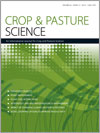CP14117Opportunities and challenges for improved management of foliar pathogens in annual clover pastures across southern Australia
Fungal foliar pathogens cause significant losses in herbage and seed yields and also in regeneration capacity in annual clover pastures, leading to their rapid deterioration and poor persistence. Host resistance offers the greatest potential for delivering the most cost-effective and long-term control. However, release of new varieties of unknown susceptibilities to major foliar diseaes, the risks posed by new pathogen races to continued use of older varieties, and the lack of flexible management options; together make successful disease management challenging.




